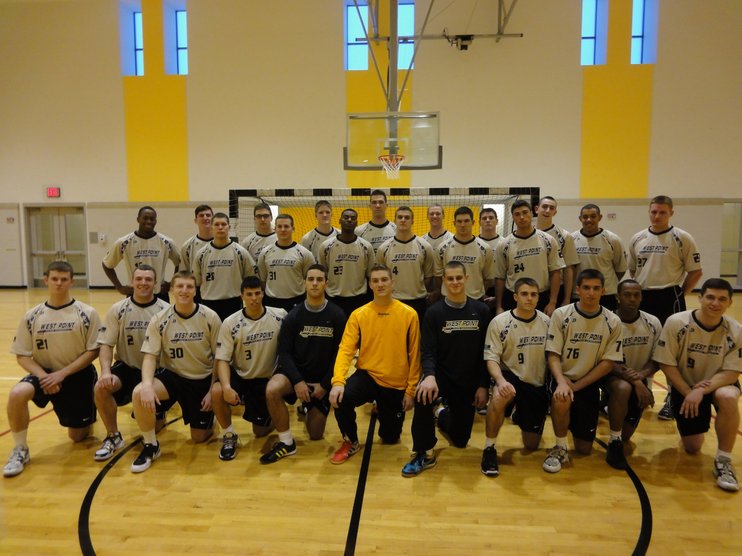
West Point (pictured) and the Air Force Academy have several graduates in the USA National Team player pool. Is it too high of a percentage?
Anyone who follows USA Team Handball’s excellent American’s Abroad updates has surely noticed that two groups of Americans (military members and dual citizens) are very well represented. It’s worth reflecting upon whether this presents a problem or concern with the sports development in the U.S. Here’s my analysis on military athletes.
There has been a long tradition of athletes with military backgrounds playing on U.S. National Teams. The 1972 Olympic team, in particular, included several army athletes that were introduced to the sport via Army sponsored training camps. Anecdotally, I’ve even been told that making the team back then had the added incentive of avoiding a tour in Vietnam. In terms of collegiate club programs West Point and to a lesser extent, the Air Force Academy have been the bulwark programs that have been around for years as other programs (with the exception of North Carolina) have come and gone. So it should come as no surprise that more graduates from these schools have gone on to join the National Teams than from any other college in the nation.
I am obviously biased, but I think most non-partial observers would also agree, that the typical service academy graduate who continues to play handball is both highly dedicated and disciplined in their approach to the sport. In simple terms they are usually highly coachable and true team players. Aside from the right attitude, their Handball skills have generally been a notch above most other collegiate programs. In other words a service academy graduate transitioning to the National Team isn’t starting at ground zero.
I suspect that the current preponderance of military athletes in the national team player pool is due to two primary reasons. First, as I already alluded to, it’s simply a reflection of a very thin talent base. This is clearly evidenced by only 4 men’s universities (West Point, Air Force, N Carolina and Texas A&M) and 2 women’s universities (West Point and N. Carolina) being represented at the recent collegiate championships. With half the schools being Service Academies and the West Point men being so dominant that they played an intrasquad scrimmage for the championship it’s no surprise that our national teams have a lot of guys with short haircuts.
The second factor, undoubtedly trending towards more military athletes is the financial support being provided by the U.S. military’s World Class Athlete Program (WCAP). This program allows military athletes in a number of different sports the opportunity to train full time in preparation for the Olympic Games. I’m sure USA Team Handball would prefer to have its own funding line to provide generous stipends to any promising athletes, but that’s not currently in the cards.
So, should we be concerned that we have too many guys in short haircuts? Yes, for two reasons.
1) First, it’s a stark indication that we need more colleges playing the sport in the U.S. If all of the athletes being identified for the next level (National team competition or pro leagues) in any sport are coming from only two schools that’s an anomaly. And such an anomaly can only be the result of either powerhouse programs gobbling up all the talent or that there just aren’t very many people playing. West Point obviously has a top notch program, but it’s more the latter than the former. So, it’s a problem, but it would be a problem if it was any two colleges in the U.S. They just happen to be Service Academies in this instance.
2) The second concern, however, is legitimately tied to the unique circumstances of military athletes. And that is what the military can giveth with WCAP it can also taketh with military service. This is evidenced by several Army players being pulled from the program after the loss to Canada last December. Relying too heavily on military athletes can severely impact a
program and given the choice (free of WCAP incentives) I’m sure that USA Team Handball would prefer developing players with no strings attached.
Should anything be done to remedy this imbalance?
Yes, but there’s no need for a plan with the specific goal of reducing our dependency of military athletes. Rather, it should simply be a natural reduction based on more top players being identified and developed through youth based programs and more colleges playing the sport. As the talent pool widens it’ll become more likely that only the top couple of players from any one school in the country will be identified as National Team prospects. And with strong traditions at schools like West Point and the AF Academy it’s probably a good bet that they will continue to provide top prospects, they just will have a smaller percentage.
So, I’ve assessed our current preponderance of military athletes on our National Teams as not a problem, but a symptom of a problem (thin talent pool). In part two, I’ll consider whether the same is true for dual citizenship athletes.

Pingback: Channel Academy Graduates